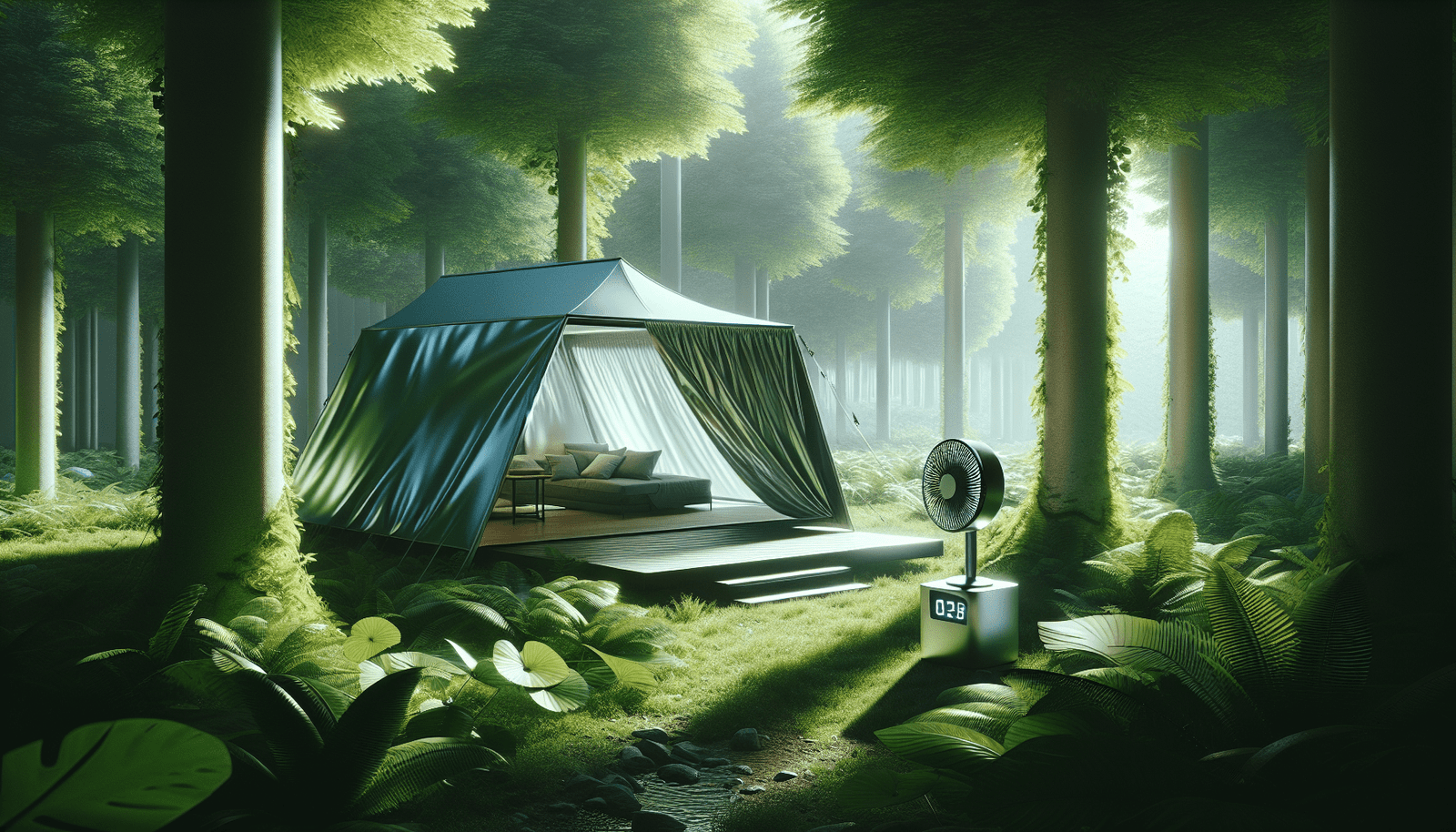When summer rays turn your camping tent into a mini sauna, knowing how to cool it down can make all the difference in your outdoor adventure. In “How To Make A Tent Cooler In Summer,” you’ll discover practical and easy-to-implement tips for beating the heat. From choosing the right tent location to utilizing reflective tarps and portable fans, this guide offers a range of strategies to help you stay comfortable under the canvas. Learn how to transform your tent into a refreshing retreat, ensuring you enjoy every moment of your summer escapade without breaking a sweat. Have you ever found yourself sweltering in your tent during a summer camping trip, wondering how to make your temporary home a bit cooler? You’re not alone! Summer camping can be absolutely delightful, but the heat can sometimes make it unbearable. The good news is, with a few tips and tricks, you can transform your tent into a cooler, more comfortable retreat even under the blazing sun.
Understanding the Heat Problem
First, let’s understand why tents get so hot. When you set up a tent in direct sunlight, the material can absorb a lot of heat. The lack of proper ventilation and the heat radiated from the ground can turn your tent into an oven. All of this can result in an uncomfortable camping experience, which is something no one wants.
Why Does My Tent Get So Hot?
Your tent may get hot for several reasons. The materials most tents are made of – nylon, polyester, and other synthetic fabrics – tend to trap heat. Combine this with poor air circulation and direct sunlight, and you’ve got yourself a stuffy, overwhelming climate inside your tent.
The Effect of Ground Heat
Another culprit is ground heat. If your tent is pitched on a spot that absorbs the sun’s rays, the heat radiating upwards can significantly increase the internal temperature of your tent. This is especially common in areas with sandy or rocky ground.
Choosing The Right Tent Site
One of the easiest ways to keep your tent cool is by choosing the right spot to pitch it. Where you place your tent can make a huge difference in its internal temperature.
Best Locations to Pitch Your Tent
- Shady Areas: Always look for natural shade. Trees or rock formations can provide excellent cover from the sun, keeping your tent significantly cooler.
- High Grounds: If possible, set up your tent on higher ground where the breeze can circulate better.
- Avoid Open Fields: Open fields are great for the view, but they offer no protection from the sun’s heat which will directly hit your tent.
| Location Type | Pros | Cons |
|---|---|---|
| Shady Areas | Natural cooling, UV protection | Limited availability |
| High Grounds | Better breeze circulation | May be hard to find level ground |
| Open Fields | Great views | No shade, increased heat |
Using Reflective Materials
Reflective materials can be your best friend when it comes to reducing tent heat. They work by reflecting the sun’s rays away from your tent.
Reflective Tarps and Sheets
Using a reflective tarp or sheet over your tent can drastically reduce the amount of heat that gets absorbed. Just ensure it’s secured well to avoid it flapping around in the wind.
| Material Type | Benefits | Drawbacks |
|---|---|---|
| Reflective Tarps | Effective heat reflection | Needs secure fastening |
| Reflective Sheets | Lightweight, easy to handle | Can be less durable compared to tarps |
Adequate Ventilation
Proper ventilation is crucial for maintaining a cool tent. Without it, you’re basically trapping all the hot air inside.
Mesh Panels and Roof Vents
Look for tents with plenty of mesh panels and roof vents. These features allow hot air to escape and cooler air to enter. If your tent lacks these, you might consider modifying it or using battery-powered fans.
Using Tent Fans
Battery-operated tent fans are a great way to improve air circulation inside your tent. Some modern fans even have misting capabilities, offering a slight cooling effect.
| Ventilation Method | Pros | Cons |
|---|---|---|
| Mesh Panels | Efficient at air circulation | Can allow insects in (use netting) |
| Roof Vents | Expels hot air, draws in cooler air | May not be available in all tents |
| Tent Fans | Additional cooling via airflow | Requires batteries |
Insulating the Tent Ground
The ground beneath your tent can radiate a surprising amount of heat. Insulating the ground can help reduce this effect.
Ground Insulation Options
- Tent Footprints: These are specifically designed to fit under your tent and provide an extra layer of insulation.
- Reflective Blankets: Place these under your tent to reflect heat back into the ground.
- Foam Mats: Besides providing comfort, foam mats can also act as an insulator against ground heat.
| Insulation Option | Benefits | Drawbacks |
|---|---|---|
| Tent Footprints | Custom fit, effective insulation | Additional cost |
| Reflective Blankets | Lightweight, easy to place | May require frequent adjustments |
| Foam Mats | Added comfort, insulation | Bulky and takes up space |
Using a Tent with the Right Fabric
The fabric of your tent can play a significant role in determining how hot it gets inside.
Best Fabrics for Hot Weather
When looking for a tent, aim for ones made of light-colored and breathable fabrics. Dark colors tend to absorb more heat, while lighter colors reflect it.
Installing a Rainfly Properly
A rainfly can act as a shield from the sun, but it needs to be used correctly.
Creating an Air Gap
When you use a rainfly, ensure there’s a gap between it and the tent. This allows air to circulate and prevents the heat from being trapped.
The Role of Hydration
Staying hydrated can make you feel cooler even when the temperature rises.
Hydration Tips
- Drink Plenty of Water: Always keep a bottle of water handy.
- Electrolyte Drinks: These can help replenish the salts lost through sweating.
- Cooling Towels: Soak them in cold water and wrap them around your neck for instant relief.
Nighttime Cooling
You can take advantage of the cooler nighttime temperatures by implementing a few strategies.
Ventilation at Night
Keep your windows and doors open to allow maximum airflow. If you’re worried about insects, consider using mosquito netting.
Avoid Overcrowding
The more people inside the tent, the more body heat gets trapped. Try to limit the number of occupants or opt for a larger tent.
Portable AC Units and Coolers
While not the most rugged option, some campers swear by portable AC units and coolers.
Types of Portable Cooling Devices
- Battery-Powered Coolers: Great for small tents, though they may require frequent battery changes.
- Portable AC Units: More effective but bulkier.
- Evaporative Coolers: Use water evaporation to cool the air but are best used in dry climates.
| Cooling Device | Benefits | Drawbacks |
|---|---|---|
| Battery-Powered Fans | Portable, easy to use | Battery-dependent, limited cooling |
| Portable AC Units | Effective cooling | Bulky, Requires power source |
| Evaporative Coolers | Water-based cooling | Best used in dry climates |
Tips for Setting Up Your Tent
Setting up your tent correctly can also contribute to keeping it cool.
Strategic Tent Orientation
- Face the Door towards Wind: This can help increase airflow.
- Use Natural Barriers: Utilize bushes or other natural barriers to provide additional shade.
Elevated Pitch
If possible, elevate your tent a few inches off the ground. This can aid in air circulation and help reduce ground heat.
Final Thoughts
Making your tent cooler during the hot summer months doesn’t have to be a Herculean task. With a little planning and the right strategies, you can significantly improve your comfort levels. From choosing the right tent site to using reflective materials, proper ventilation, insulation, and even portable cooling devices, there’s a lot you can do to keep the heat at bay.
So, the next time you go camping, try out some of these tips. Not only will your tent be cooler, but your entire camping experience will be much more enjoyable. Happy camping!
And there you have it! You’re now well-equipped with all the knowledge you need to keep your tent cool this summer. Enjoy your camping adventures without sweating it out!

